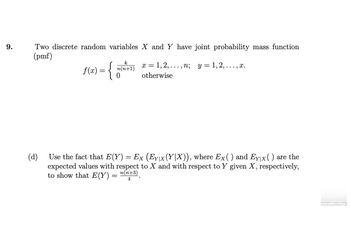
A First Course in Probability (10th Edition)
10th Edition
ISBN: 9780134753119
Author: Sheldon Ross
Publisher: PEARSON
expand_more
expand_more
format_list_bulleted
Question
I asked this question yesterday and got what looks like a computer generated answer that seems wrong. It iterates beteen similar mathematical states without apparent purpose and ands up in a non true statement as far as I can tell. I still need help understanding how to solve the problem and kindly ask to have one more go.

Transcribed Image Text:9.
Two discrete random variables X and Y have joint probability mass function
(pmf)
f(x) = {
k
n(n+1)
0
1,2, ..., n; y = 1, 2, . . . , x.
otherwise
Xx =
(d)
Use the fact that E(Y) = Ex (Ey\x(Y|X)), where Ex( ) and Ey|x( ) are the
expected values with respect to X and with respect to Y given X, respectively,
to show that E(Y) = n(n+³)
4
Expert Solution
This question has been solved!
Explore an expertly crafted, step-by-step solution for a thorough understanding of key concepts.
Step by stepSolved in 6 steps with 8 images

Knowledge Booster
Similar questions
- I am having trouble understanding the solution. Also the hints do not seem to be used. Some elaboration would be great, thanks!arrow_forwardFor the following questions, THERE IS NO NEED FOR EXPLANATION. PLEASE PROVIDE JUST THE ANSWER THANK YOU. Please DO NOT waste time on writing things to explain. Please answer in 30 mintues or else I will write a bad review. If you follow my rules and answer in less than 30 mintues then I will write a very long and wonderful review about you. ANSWER the questions correlty and please answer all the questions with what it regards in saying exactly.arrow_forwardSolve the problem below. For your initial post in Brightspace, copy the description of your company given in the box below and then enter your solution to all three parts (parts a, b, and c) of the problem. To copy the description of your company, highlighting and using "copy" from here in Mobius and then using "paste" into Brightspace should work. However, if when you copy and paste x you get a 2 instead, then change your x2 to x^2. Hint: We covered this topic in "2-1 Reading and Participation Activities: Quadratic Equations" in Module Two. You can check your answer to part b to make sure that you are on the right track. For a certain company, the cost for producing x items is 40x +300 and the revenue for selling a items is 80r - 0.5x2. The profit that the company makes is how much it takes in (revenue) minus how much it spends (cost). In economic models, one typically assumes that a company wants to maximize its profit, or at least wants to make a profit! Part a: Set up an expression…arrow_forward
- Please show as much work as possible, and please do not skip steps. I really want to learn how to solve this, so if you use a axiom please include it. Problem Statement: One out of every one- thousand people have disease X. A new test for X is available, but it's not very accurate. If you have X, there is an 80% chance the test comes back positive and a 20% chance it comes back negative. If you don't have X, there is a 60% chance the test comes back negative and a 40% chance it comes back positive. Question: You are randomly chosen to be tested for X. Since the test is not very accurate, you areadministered the test 10 times; assume the outcomes of these 10 tests are independent. Sevenout of the 10 tests come back positive. Given these test results, what is the probability youhave X?arrow_forwardFor the following questions, THERE IS NO NEED FOR EXPLANATION. PLEASE PROVIDE JUST THE ANSWER THANK YOU. Please DO NOT waste time on writing things to explain. Please answer in 30 mintues or else I will write a bad review. If you follow my rules and answer in less than 30 mintues then I will write a very long and wonderful review about you. ANSWER the questions correlty and please answer all the questions with what it regards in saying exactly.arrow_forwardPlease help me with question #5 with as much explanation as possible please. I really want to understand thisarrow_forward
- Hello, I have been stuck on this question for a while now. I believe I did all the steps right thus far if I did not make a mistake somewhere down the line, I have not been able to find a way to know what A=? and what B=? could anyone spot a mistake that I could have made down the line or what might be my next step to finally finding what A and B are equal to? Thanks, you!arrow_forwardIf there are three kinds of cat food an experimenter will be feeding to cats and measueing the amount, they are feed, to then predict the number to active minutes the cat has in a day. They want to include the kind of cat food as a dummy variable. (a) Propose a scheme with 2 dummy variable in addition to the constant that would work and show it works? (b) Do the following propsed dummy variable schemes work? (show your work)arrow_forward
arrow_back_ios
arrow_forward_ios
Recommended textbooks for you
 A First Course in Probability (10th Edition)ProbabilityISBN:9780134753119Author:Sheldon RossPublisher:PEARSON
A First Course in Probability (10th Edition)ProbabilityISBN:9780134753119Author:Sheldon RossPublisher:PEARSON

A First Course in Probability (10th Edition)
Probability
ISBN:9780134753119
Author:Sheldon Ross
Publisher:PEARSON
